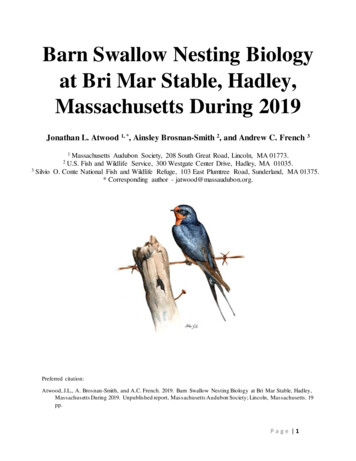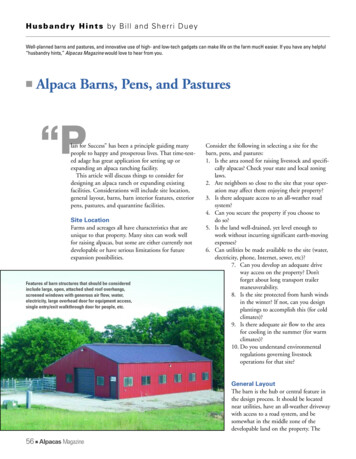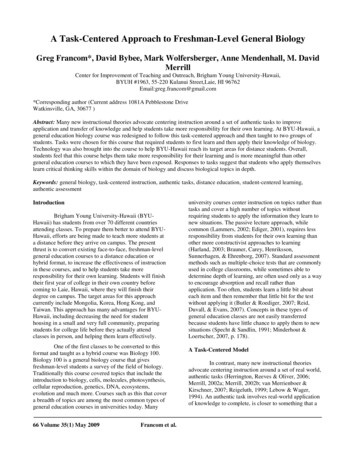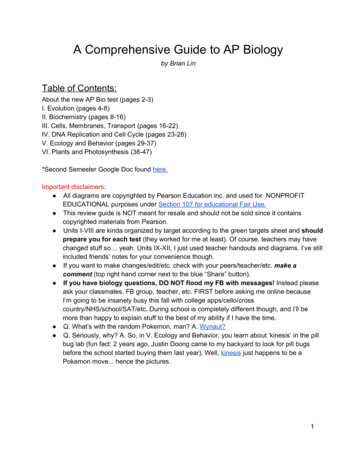
Transcription
Barn Swallow Nesting Biologyat Bri Mar Stable, Hadley,Massachusetts During 2019Jonathan L. Atwood 1, *, Ainsley Brosnan-Smith 2, and Andrew C. French 31Massachusetts Audubon Society, 208 South Great Road, Lincoln, MA 01773.U.S. Fish and Wildlife Service, 300 Westgate Center Drive, Hadley, MA 01035.3 Silvio O. Conte National Fish and Wildlife Refuge, 103 East Plumtree Road, Sunderland, MA 01375.* Corresponding author - jatwood@massaudubon.org.2Preferred citation:Atwood, J.L., A. Brosnan-Smith, and A.C. French. 2019. Barn Swallow Nesting Biology at Bri Mar Stable, Hadley,Massachusetts During 2019. Unpublished report, Massachusetts Audubon Society; Lincoln, Massachusetts. 19pp.P age 1
AbstractThe Barn Swallow (Hirundo rustica) has declined throughout the northeastern U.S. from 1966 –2017. Modern farming techniques, declining insect populations, or mortality associated withclimate changes have been postulated as probable causes of these declines. There is little evidencethat loss of nesting sites has an important influence on regional population levels. Nonetheless,plans by the U.S. Fish and Wildlife Service (USFWS) for the removal of an unused horse stablethat supports a large breeding colony of Barn Swallows on the Fort River Division of the SilvioO. Conte National Fish and Wildlife Refuge in Hadley, Massachusetts, have raised controversia lquestions regarding the regional importance of this colony. In 2019 we mapped 51 active BarnSwallow nest locations within the former Bri Mar Stable. The maximum number of simultaneo us lyactive nests was 40 on 4 June, with a later pulse of 26 nests on 24 July. Banding data indicated thatmost of the late season nests represented second broods of pairs that had nested earlier at the site .If the stable is removed, as proposed by the USFWS, active nest sites used in 2019 would beeliminated, potentially forcing any returning adults that had previously used these sites toultimately relocate to nearby structures on the refuge or to other colonies in the general region.Deployment of 18 seed nests (nests built in previous years that were physically moved,prior to the 2019 nesting season) into a nearby structure, coupled with vocalization playbacks,may have contributed to selection of this alternate site by 6-7 pairs; this building had been usedby smaller numbers of nesting swallows in previous years. Preliminary surveys of other barns andstructures near the stable found at least 1 other breeding colony of possibly comparable size. If theUSFWS does proceed with the removal of the existing stable, we believe it will be possible tomaintain a regional Barn Swallow population that is comparable to current levels.IntroductionThe Barn Swallow (Hirundo rustica) is a widespread, common species that occurs througho utmost of the world. In North America, USGS Breeding Bird Survey data (Sauer et al. 2017) indicatethat, over a 45-yr period (1970–2014), the overall population of this species in the United Statesand Canada has decreased by an estimated 38% (Rosenberg et al. 2016). The Canadian populationhas declined approximately 80% since 1970, leading the Committee on the Status of EndangeredWildlife in Canada (COSEWIC) to assess the Barn Swallow as Threatened (COSEWIC 2011).Population trends within the Barn Swallow’s North American range vary geographically (Fig.1). Numbers are increasing in the southern tier of states from Arizona east to North Carolina. Allof the Canadian provinces, California, and northwestern, midwestern, northeastern and mid Atlantic states generally show declining populations (with trends that are less pronounced in themidwest). In Massachusetts, Barn Swallows have clearly declined; based on 29 Breeding BirdSurvey routes, there has been an estimated 1.1% annual decline in abundance of the species from1966-2017 (Fig. 2; Sauer et al. 2017). These declines were not reflected by MassachusettsBreeding Bird Atlas data, which showed a stable or increasing state-wide breeding distributio nbetween 2 atlas periods (1974-1979 and 2007-2011), although Walsh and Petersen (2013)P age 2
nonetheless commented that the species merited “further monitoring and conservation action.” TheBarn Swallow is not one of 95 birds listed as “species of greatest conservation need” in the 2015Commonwealth of Massachusetts Wildlife Action Plan.The causes of Barn Swallow declines are unclear. At a global scale, BirdLife Internatio na l(2016) stated that “The main threat to the species is the intensification of agriculture. Changes infarming practices such as the abandonment of traditional milk and beef production have resultedin a loss of suitable foraging areas. In addition, intensive livestock rearing, improved hygiene, landdrainage and the use of herbicides and pesticides all reduce the numbers of insect prey available.Suitable nest sites for Barn Swallows are often scarcer on modern farms. The species is susceptibleto changes in climate with bad weather in the wintering areas as well as the breeding groundsaffecting breeding success (Tucker and Heath 1994). It is occasionally hunted for sport and nestsare sometimes removed as a nuisance. In North America, introduced House Sparrows (Passerdomesticus) are serious nest- site competitors, taking over nests and destroying eggs and nestlings(Turner and Christie 2012).” In Canada, COSEWIC (2011) concluded that “the main causes [ofdecline] . . . are thought to be: 1) loss of nesting and foraging habitats due to conversion fromconventional to modern farming techniques; 2) large-scale declines (or other perturbations) ininsect populations; and 3) direct and indirect mortality due to an increase in climate perturbationsFig. 1. North American population trends of Barn Swallow, by state and province, based on USGS BreedingBird Survey data, 1966-2017 (https://www.mbr-pwrc.usgs.gov/, scale states; Sauer et al. 2017).P age 3
on the breeding grounds (cold snaps).” Møller (1989) suggested that in [the Barn Swallow’sEuropean subspecies] H. r. rustica, overwinter mortality was thought to be the primary factorregulating population size, although he also noted that the number of swallows in Denmarkdeclined when dairy farming was shifted to crop production (Møller 2001). Brown and Brown(1999, 2019) proposed that “weather-related mortality during cold snaps . . . probably regulatespopulation size, at least in northern portions of the breeding range, and may determine the northernlimit of the species’ range.” Nebel et al. (2010) concluded that “the taxonomic breadth of thesedownward trends [among 24 species of aerial insectivores] suggests that population declines arelinked to changes in populations of flying insects, and these changes might be indicative ofunderlying ecosystem changes.” Brown and Brown (2019) concluded that “many populations [ofBarn Swallows] are probably not regulated by nest-site availability,” citing Holroyd’s (1975)observation that local numbers of breeding pairs often remain stable even when the availability ofsuitable nesting sites increases. Similarly, Robinson et al. (2003) found, in a study which coveredall of Britain, that “there was little evidence of an association between change in the [availabilityof] nest-sites . . . and change in Swallow numbers.”Fig. 2. Massachusetts population trends of Barn Swallow based on USGS Breeding Bird Survey data, 19672017 (https://www.mbr-pwrc.usgs.gov/, scale states; Sauer et al. 2017). Y axis represents averagepredicted abundance of individuals per fixed survey route. Dashed lines indicate upper and lower 95%confidence intervals.P age 4
A sizable colony of Barn Swallows has nested at Bri Mar Stable (hereafter, “stable”), FortRiver Division, Silvio O. Conte National Fish and Wildlife Refuge, Hadley, Massachusetts inrecent years, and plans by the U.S. Fish and Wildlife Service (USFWS) to remove this structure ,outside of the breeding season, due to concerns over public and employee safety, administra tivedirective to reduce the USFWS’ structural footprint, threat to adjacent buildings, and lack of valueto the refuge’s overall mission have raised questions regarding the importance of this colony tothe regional population of this declining species. How does the colony in the stable compare insize to other nesting sites in the general vicinity? Would removal of the stable affect some, or all,of these pairs, and would the regional population be impacted? Are there ways to mitigate theproposed removal of the stable, perhaps including attraction of displaced pairs or first- timebreeders to alternative nesting sites that could be protected? If the regional population of BarnSwallows is not regulated by nest site availability, then what other factors might be examined asimportant to the species’ conservation? Can Barn Swallows serve as a flagship species on therefuge and within the Connecticut River watershed to increase public awareness of aerialinsectivore declines?In 2019 Mass Audubon’s Bird Conservation Department, in collaboration with the Silvio O.Conte Refuge, conducted a focused study of Barn Swallow breeding ecology at Bri Mar Stable,aiming to collect data that may inform decisions regarding future plans of the refuge. The studyincluded three primary elements: (1) record, map and characterize active nests within the stable atfrequent intervals throughout the nesting season, (2) capture, band, and release adult and fledglingBarn Swallows in order to quantitatively evaluate the number of individuals using the stable,including assessment of the phenology of breeding activities during 2019 and establishment of amarked population for potential future study in 2020, and (3) conduct preliminary surveys ofnesting activities in nearby barns and other structures located in the general vicinity of Hadley.This report presents the results of these efforts, and makes recommendations for future research in2020.Field Site DescriptionThe Silvio O. Conte National Fish and Wildlife Refuge project area encompasses the 7.2million-acre watershed of the Connecticut River. Land acquisition, a traditional conservation tool,is limited to specific high priority sites located in four states. The refuge uses innovativepartnerships to improve conservation efforts, research important questions, foster conservationleadership and inform citizens about critical issues. Priority sites are strategically connected to theexisting mosaic of conservation land already within the watershed. Presently, the refuge totals37,795 acres located in 22 different locations in the 4 states (Connecticut, Massachusetts, NewHampshire, and Vermont) within the watershed. The Fort River Division, located in Hadley,Massachusetts, occurs in the eastern portion of the Pioneer Valley. In 2009, the USFWS acquiredthe 66.5 acre Zuckerman ownership for 2.1 million and added it to the Fort River Division of therefuge; the property had been slated to become 56 house lots. Four structures were included in thepurchase; three of these, a residence, a shop building, and a former indoor horse exercise arenaP age 5
with an attached 1,600 ft2 hot walker room (hereafter referred to as the Boat House), are consideredto be key assets for refuge operations in the four state area. The fourth structure is the Bri MarStable (42 26'24"N, 72 34'12"W), a 30-year-old, two-story building, with each floor approx.11,250 ft2 in extent (Fig. 3). The USFWS has evaluated two alternatives that would result in thedemolition and removal of the stable by the close of Fiscal Year 2020, ending on 30 September2020.Approximately 58% of the Fort River Division is composed of pasture and grasslands . Within2.5 mi of the stable are approximately 4,800 acres of agricultural land that is potentially used forforaging by nesting Barn Swallows (Brown and Brown 2019).Fig. 3. Location of Bri Mar Stable, Conte National Wildlife Refuge, Hadley, Massachusetts.[This Space Left Intentionally Blank]P age 6
MethodsPrior to the 2019 breeding season, we mapped the location of 82 sites within Bri Mar Stablethat were considered, based on evidence of exploratory nesting activities during previous years, tobe potential Barn Swallow nest locations. These sites were inspected, using a telescopic mirror, atapproximately one-week intervals from 7 May – 13 August. At each of the 51 sites that were usedat some point in 2019 we recorded the characteristics of the nests’ supporting structures (hangingfluorescent light fixtures, metal conduit leading to the fluorescent light fixtures, wooden framing,PVC drainage pipe, artificial nest bowls made of wood or clay, and metal-caged stall lights). Tofacilitate mapping of nest locations, the interior of the stable was gridded into 78 12 ft X 12 ftunits; distances to the center of each of these grid cells was calculated as a straight line to thenearest access opening to the stable (approx. 5 ft wide by 8 in high). Distances of the 51 used nestsites relative to the nearest access openings, 2 of which were located at either end of the stable,were calculated as straight lines using GIS.In order to develop and test possible techniques that might be used to attract displaced swallowsor first time breeders to nest at locations where they could be effectively protected, in 2019 therefuge installed 18 “seed nests” (actual Barn Swallow nests that had been physically moved, priorto the nesting season, from their original locations) in the Boat House. Twelve of these seed nestswere obtained from the western third of Bri Mar Stable, and 6 were recovered and relocated withinthe Boat House itself. At 5 of the sites (42%) from which nests had been removed from Bri MarStable prior to the 2019 season, new nests were built during 2019. Three of these rebuilt nests wereused in 2019, including one where 2 clutches were laid.Additionally, 264 potential nest site contact points were placed by the USFWS within the BoatHouse. The contact points attempted to mimic nest site supports that were used by Barn Swallowsin the stable. These were evenly attached within each of two sizes of wooden hanging structures(8 ft X 8ft and 4 ft X 4 ft), and consisted of readily available hardware materials: A conduit; B electrical box; C wire mesh; D wooden shelf (5 in X 5.5 in); E hurricane brace; and F corner bracket (Fig. 4).During mornings we used playbacks of Barn Swallow vocalizations that were continuo us lypresented in the Boat House to encourage pairs to enter the structure and perhaps build nests withinthe building. Once several active nests had been established in the Boat House, use of playbackswas terminated in late July.A total of 134 swallows were captured, using 36-mm mesh Japanese mist nets, banded andreleased within the stable on nine dates (7 May, 28 May, 13 Jun, 28 Jun, 9 Jul, 19 Jul, 25 Jul, 1Aug, 13 Aug). Using criteria provided by Pyle (1997), 46 individuals were identified as females,and 44 birds were identified as males; 44 birds (including recent fledglings and some adults thatwere captured late in the season after recession of secondary sexual characters and occurrence ofexcessive tail feather wear) could not be sexed. Banding was conducted under authorization ofFederal (Master Bird-Banding Permit 09996) and State (Massachusetts Scientific CollectingPermit 196.19SCB) permits issued to the senior author.P age 7
Fig. 4. Partial view of the interior of the Boat House, showing examples of contact points (A-G) and fecalcapture screens (H). A conduit; B electrical box; C wire mesh; D wooden shelf; E hurricanebrace; F corner bracket; G wooden shelf with seed nest.ResultsDistribution of Nests and Phenology of Breeding ActivityA total of 82 potential nest site locations of various types and condition were mapped withinBri Mar Stable at the start of the 2019 breeding season (Fig. 5). Thirty-one of these locations werenot used in 2019. Twenty-five (81%) of these unused nests were well developed and typical BarnSwallow nests; we do not know whether these nests were not used in 2019 because of theavailability of other more suitable sites, the presence of parasites, or some other influence. All ofthe remaining 51 locations were used for actual nesting at least once during the season. Of the 51nest sites that were used during 2019, 27 (52.9%) were located on hanging fluorescent lightfixtures, 9 (17.6%) on metal conduit leading to the fluorescent light fixtures, 7 (13.7%) on woodenP age 8
framing, 3 (5.8%) on PVC drainage pipe, 3 (5.8%) on artificial nest bowls made of wood (n 1) orclay (n 2), and 2 (3.9%) on metal-caged stall lights.The majority (94%) of the 51 nest sites that were used within Bri Mar Stable in 2019 werelocated in the eastern and western ends of the structure; only 3 nests were located in the stable’s“middle” portion (Fig. 5). Distance of nest sites to the closest entrance into the stable averaged30.6 ft (SD 20.8). The number of nests found within each grid cell generally decreased awayfrom the nearest access opening to the stable.Fig. 5. Distribution of Barn Swallow nests in Bri Mar Stable, 2019. Unused sites reflect locations whereswallows had shown evidence of possible nest site selection in previous years. Bold blue lines at either endof diagram indicate access windows into the structure.Based on distances of nests to the stable’s access openings, there was no evidence thatswallows preferred one end of the structure over the other (Wilcoxon 2-sample test, Z -0.104, P 0.92). There was no difference in the distances between access openings into the stable and nestsites that were used once vs. twice in 2019 (Wilcoxon 2-sample test, Z 1.82158, P 0.07).Brown and Brown (2019) noted that “Active nests can be as close together as 0.1 m”. In BriMar Stable we found 2 active nests that were located on either side of a 1.5 inch thick ceiling joist.P age 9
Approximate nest densities in the 3 sections of the stable were 0.006 nests / ft2 (western end, 4,661ft2 ), 0.001 nests / ft2 (middle section, 2,799 ft2 ), and 0.005 nests / ft2 (eastern end, 4,661 ft2 ).Calculated at a finer scale of 28 occupied 12 ft X 12 ft grid cells, densities ranged from 0.05 nests/ ft2 to 0.007 nests / ft2 , with a mean of 0.02 nests / ft2 (SD 0.01).A total of 69 nesting attempts were recorded at 51 sites. Thirty-three (65%) of the 51 sitessupported a single nesting attempt, and 18 (35%) were used in 2 consecutive attempts (Fig. 5). Wehave no way of knowing whether sites that were used during 2 nesting attempts were occupied bythe same pair in each case. Other researchers have found that reuse of nests that were occupiedearlier in the same year varies, ranging from 12% of 50 nests in Manitoba (Barclay 1988), 45% of137 nests in Kansas (Anthony and Ely 1976), and 81% of 16 nests in Oklahoma (Iverson 1988).Shields (1984) found that 53% of marked birds in New York reused the same nest for a secondnesting attempt.The maximum number of simultaneously active nests present within Bri Mar Stable during2019 was 40, as counted on 4 June (Fig. 6). A second wave of nesting within the stable was evidentbeginning during the first week of July, peaking at approximately 26 simultaneously-active nestson 24 July. These totals do not include the approximately 2 nests that were present on the secondfloor of the stable building, which could not be regularly accessed due to safety concerns posed bythe rotting plywood floor, or the 6 seed nests that were used in the nearby Boat House that weremonitored on the same schedule as the stable.Of the 26 nests that were active on 24 July, 16 (62%) had been used earlier in the season duringthe initial pulse of nesting. We have no way of certainly knowing (a) whether these “second wave”nests represented second broods from some of the original 40 pairs, (b) whether some (all?) of thenests initiated in July resulted from late breeders that had not earlier nested in the stable during2019, or (c) were birds that had been displaced or relocated from elsewhere within the locallandscape. However, banding data (see below) suggests that most late breeders in 2019 had nestedearlier in the season within the stable.Clutch size at Bri Mar Stable in 2019 ranged from 2-7 eggs (mean 4.43, SD 0.99). A totalof 306 eggs were known to have been laid. Excluded from these values was a single nest containing2 inviable “runt” eggs (see Czechowski and Zduniak 2008, Mulvihill 1987, and Rothstein 1973for reviews of this rare phenomenon). Hatching and fledging success was high; of 69 nestingattempts, we recorded only 1 complete nest failure. Because we wished to avoid undue disturbanceof nests containing about-to-fledge young, we did not consistently attempt to record whether anesting attempt included unhatched eggs.[This Space Left Intentionally Blank]P a g e 10
Fig. 6. Approximate nesting phenology of Barn Swallows at Bri Mar Stable, 7 May – 16 August 2019.Weisheit and Creighton (1989) described adverse impacts of House Sparrows on nesting BarnSwallows. At one nest site in the stable, a recently-vacated House Sparrow nest was removed on18 June, and the site was almost immediately occupied by a Barn Swallow pair which had laid aclutch of 5 eggs eight days later. At an additional nest site where we removed the early stages ofHouse Sparrow nest construction, there was no subsequent use by Barn Swallows (or HouseSparrows).We saw no evidence of infanticide. Brown and Brown (2019) stated that “infanticide is morecommon in large colonies, which apparently attract unmated males.” At a colony of 50 nests inNebraska, Hoskin (1988) found that 78.3% of 69 nests failed; most failures were presumed due toinfanticide or conspecific egg destruction. Based on banding data (see below) there was noevidence of a biased sex ratio in the Bri Mar Stable colony in 2019, which might have beenexpected if there were substantial numbers of unmated males.Of the 18 seed nests deployed within the Boat House, 6 (33%) were occupied in 2019,including 1 that was used for two consecutive broods. None of the artificial nest site contact pointsplaced within the Boat House were used. However, three of the artificial structures placed in offsitelocations within the area had successful brooding where, in the absence of deployed seed nests,the electrical boxes were the contact point of preference for nest building.P a g e 11
BandingA total of 134 swallows were banded and released at Bri Mar Stable on nine dates in 2019,including 49 birds that were initially captured on the west end of the stables, 60 birds that wereinitially captured on the east end of the stables, and 25 birds that were initially captured in the BoatHouse (Table 1). Banding efforts were not consistent among the various portions of the stables, sodifferences in capture numbers do not reflect controlled comparisons.Table 1. Initial capture totals, by age classification, in Bri Mar Stable and the Boat House in 2019. HY hatching year (recent fledglings, hatched in 2019); AHY after hatching year (birds hatched in 2018 orearlier).AGEAHYHYBoat HouseStables - EStables - W9504016109There was considerable movement of individuals among the 3 banding locations – notsurprising considering the close proximity of the different sites; in fact, Stables – East and Stables– West are at opposite ends of the approx. 156 ft long Bri Mar Stable building, and the center ofthe Boat House is located only 240 ft from the stable’s center. Of 40 birds initially captured inStables – West, 24 were recaptured on at least 1 subsequent date in Stables – East. Of 50 birdsinitially captured in Stables – East, 24 were recaptured on at least 1 subsequent date in Stables –West. One of the 25 birds captured in the Boat House was also captured in Stables – West.There were 165 recaptures of adults, representing 105 individuals. Predictably, the frequenciesof recaptures increased over the course of the season as more and more birds had previously beencaptured and banded (Fig. 7). There was a noticeable decline in the number of adults that werecaptured on 9 July; between 28 June and 9 July many nests fledged, and associated adults andjuveniles began to spend less time inside the stable area where nets were erected. The first hatchyear (HY) birds (juveniles capable of sustained flight) were captured on 28 June. The relativeabsence of newly banded adults beginning in early July suggests that the second wave of nestinitiations observed during July (see Fig. 6) was dominated by birds attempting to raise a secondbrood, as opposed to immigrants that were newly arrived from other sites.P a g e 12
Fig. 7. Captures of adult Barn Swallows at Bri Mar Stable (including the Boat House) during 2019.“Initials” indicate birds that had previously not been banded; “Recaps” indicate recaptured birdsthat had previously been banded.The proposed demolition of Bri Mar Stable was scheduled, according to the Environme nta lAssessment (EA) published by the USFWS, to involve a phased closure of the structure in thirds,beginning with the western portion prior to the 2019 nesting season, followed by the closure of themiddle portion prior to the 2020 nesting season and, finally, the entire building would be removedafter the end of the 2020 nesting season. To date, the USFWS has not made a final decisionconcerning the management alternatives presented in the EA, and the initially proposed timeschedule has been delayed. In this study we worked under the assumption that data collected during2019 could inform future management decisions within and around the Fort River Division of theSilvio O. Conte National Fish and Wildlife Refuge. No removal of any portion of the stablestructure occurred during the 2019 breeding season.Most 1-year-old Barn Swallows do not return to their natal colony: 0.4% (n 679) in Kansas(Anthony and Ely 1976), 0.6% (n 524) in Oklahoma (Iverson 1988), 1.0% (n 1,008) inPennsylvania (Bell 1962), 2.0% (n 331) in New York (Shields 1984), and 2.0% (n 1,718) inMassachusetts (Mason 1953). However, once a nesting site has been selected, reported return ratesof breeders are higher, ranging from 20% in Oklahoma (Mason 1953) to 42% in New York(Shields 1984). Hasegawa et al. (2012) and Mason (1953) found that the presence of previousyears’ nests was an important attractant to prospecting birds, although reuse of old nests increasedthe problem of lowered reproductive success caused by mite infestation (Barclay 1988, Donahueet al. 2018, Turner 2004). T. Imlay, working in Nova Scotia, suggested that large colonies may bemore stable over time than smaller colonies (Canadian Wildlife Service, pers. comm. dated 17May 2019), a pattern that has been reported in other colonially-nesting birds (Kharitonov andSiegel-Causey 1988). However, Brown and Brown (2019) suggested that under historic, naturalconditions, most Barn Swallows probably nested individually or in small groups; these authorsconsidered a nesting colony of 35 nests to be unusual, and noted that “studies of coloniality inP a g e 13
Barn Swallows have revealed few advantages of group living.” In Denmark, Møller (1987) foundthat the costs of coloniality were more obvious than the benefits: birds nesting in larger coloniesfound less food, spent more time guarding their mates and nests, experienced more extra-paircopulations, more ectoparasitism, more predation, more infanticide, and more brood parasitism.Similarly, in New York, Shields and Crook (1987) found that fewer young fledged from nests inlarger groups than from solitary nests or nests in small groups, suggesting a net reproductive costto coloniality.Based on the distribution of Barn Swallow nests present in the Bri Mar Stable in 2019, removalof the structure would eliminate 51 sites that were used in 2019, thereby forcing any returningadults that had been associated with these nests to relocate to the Boat House or other colonies inthe general region. However, even without displacement, Mason (1953) and Shields (1984)reported year-to-year return rates of breeders to a particular nesting site to be 50%.The Boat House, approx. 40 ft X 40 ft in size, will be maintained in future years for equipmentstorage, and will remain available to nesting Barn Swallows and other aerial insectivores. If thisbuilding were to eventually be occupied at a density comparable to what was observed during 2019in either end of Bri Mar Stable, approx. 10 pairs might be predicted to nest in the structure; usingaverage densities calculated at the finer scale of the 12 ft X 12 ft grid cells, the Boat House mightsupport approx. 32 pairs of swallows.Six Barn Swallow nest sites were active within the Boat House in 2019; one was used for 2consecutive clutches (meaning that 6-7 pairs used the Boat House in 2019). We deployed seednests and broadcast vocalization playbacks within the Boat House to attract prospecting birds (1year old first-time breeders, birds that were renesting after nest failures earlier in 2019, or birdsthat had been displaced from other nesting colonies in the region). All 7 of the 2019 Boat Housenests were laid on seed nests, and all were successful. None of the manufactured contact pointswere used. Barn Swallows have previously been observed using the Boat House in small numbers,although census figures from previous years are somewhat vague: in 2014 there was 1 pair, in2015 1 pair, in 2016 2 - 6 pairs, in 2017 no more than 3 pairs, and in 2018 2 pairs (D. Straley, M.Silver, G. Regmund and S. Chapko, pers. comm. from M. Silver, dated 20 Nov 2019). The 6-7pairs observed during 2019 appear to represent a slight increase in Boat House nesting activity. Asmentioned above (banding), there was at least some movement of banded individuals between thestable and the Boat House.Nine 4 ft X 4 ft wooden structures, each with 6 artificial contact points, were placed in 4 otherprivate farm buildings in three locations in the Hadley and Amherst area. No seed nests orvocalization playbac
P a g e 1 Barn Swallow Nesting Biology at Bri Mar Stable, Hadley, Massachusetts During 2019 Jonathan L. Atwood 1, *, Ainsley Brosnan-Smith 2, and Andrew C. French 3 1 Massachusetts Audubon Society, 208 South Great Road, Lincoln, MA 01773. 2 U.S. Fish and Wildlife Service, 300 Westgate Cen










